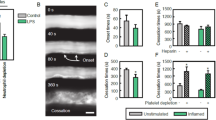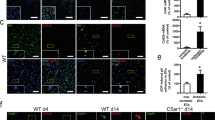Abstract
THE adhesion of neutrophils to vascular endothelium is an early event in their recruitment into acute inflammatory lesions1. In evaluating potential neutrophil–endothelial adhesive mechanisms in acute inflammation, important considerations are that adhesion in vivo may occur very rapidly following injury2–4 and that the specificity of the reaction resides in altered endothelium5. That is, neutrophils adhere only to altered endothelium adjacent to an inflammatory focus, rather than at random as would be expected if activation of neutrophils were the initiator of adhesion. We have explored a possible bridging role for complement in causing early neutrophil–endothelial cell adhesion. The complement system is involved in inflammatory processes, is capable of rapid amplification, and endothelial complement fixation at sites of inflammation could generate an endothelium-restricted signal for neutrophil adhesion. We have now developed a model in which this can be investigated without complicating factors such as immunoglobulin deposition, by constructing a novel molecule, a hybrid of the endothelial binding lectin Ulex europaeus I (ref. 6) and of the complement activator cobra venom factor7,8. This molecule has the capacity to cause fixation of complement on human unbilical vein endothelial cells. We show that complement fixation is a potent and rapid stimulus for neutrophil adhesion. Neutrophil adhesion requires only endothelial deposition of C3, and is mediated through the type 3 complement receptor.
This is a preview of subscription content, access via your institution
Access options
Subscribe to this journal
Receive 51 print issues and online access
$199.00 per year
only $3.90 per issue
Buy this article
- Purchase on Springer Link
- Instant access to full article PDF
Prices may be subject to local taxes which are calculated during checkout
Similar content being viewed by others
References
Florey, H. W. General Pathology (Lloyd-Luke, London, 1970).
Allison, F., Smith, M. R. & Wood, W. B. J. exp. Med. 102, 655–668 (1955).
Atherton, A. & Born, G. V. R. J. Physiol. 222, 447–474 (1972).
Björk, J. & Smedegård, G. Int. Archs. Allergy appl. Immun. 74, 178–185 (1984).
Cohnheim, J. lectures on General Pathology (New Sydenham Society, London, 1889).
Holthöfer, H. et al. Lab. Invest. 47, 60–66 (1982).
Müller-Eberhard, H. J. & Fjellström, K-E. J. Immun. 107, 1666–1672 (1971).
Vogel, C-W., Smith, C. A. & Müller-Eberhard, H. J. J. Immun. 133, 3235–3241 (1984).
Gamble, J. R. et al. Proc. natn. Acad. Sci. U.S.A. 82, 8667–8671 (1985).
Sanchez-Madrid, F. et al. J. exp. Med. 158, 1785–1803 (1983).
Ross, G. D. & Lambris, J. D. J. exp. Med. 155, 96–110 (1982).
Wright, S. D. et al. Proc. natn. Acad. Sci. U.S.A. 85, 7734–7738 (1988).
Altieri, D. C. & Edgington, T. S. J. biol. Chem. 263, 7007–7015 (1988).
Schreiber, R. D., Götze, O. & Müller-Eberhard, H. J. J. exp. Med. 144, 1062–1075 (1976).
Ripoche, J. A., et al. J. exp. Med. 168, 1917–1922 (1988).
Bevilacqua, M. P. et al. J. clin. Invest. 76, 2003–2011 (1985).
Bevilacqua, M. P. et al. Proc. natn. Acad. Sci. U.S.A. 84, 9238–9242 (1987).
Smith, C. W. et al. J. clin. Invest. 82, 1746–1756 (1988).
McCluskey, R. T. & Fienberg, R. Hum. Path. 14, 305–315 (1983).
Johnston, G. I., Cook, R. G. & McEver, R. P. Cell 56, 1033–1044 (1989).
O'Shea, J. J. et al. J. Immun. 134, 2580–2587 (1985).
Iida, K., Mornaghi, R. & Nussenzweig, V. J. exp. Med. 155, 1427–1438 (1982).
Dana, N. et al. J. Immun. 137, 3259–3263 (1986).
Arnaout, M. A. et al. J. clin. Invest. 72, 171–179 (1983).
Eddy, A. et al. Clin. Immun. Immunopath. 31, 371–389 (1984).
McMichael, A. J. et al. Leucocyte Typing III. White Cell Differentiation Antigens (Oxford University Press, 1987).
Keizer, G. D. et al. Eur. J. Immun. 15, 1142–1147 (1985).
Wright, S. D. et al. Proc. natn. Acad. Sci. U.S.A. 80, 5699–5703 (1983).
Jaffe, E. A. Biology of Endothelial Cells. (Nijhoff, The Hague, 1984).
Author information
Authors and Affiliations
Rights and permissions
About this article
Cite this article
Marks, R., Todd III, R. & Ward, P. Rapid induction of neutrophil–endothelial adhesion by endothelial complement fixation. Nature 339, 314–317 (1989). https://doi.org/10.1038/339314a0
Received:
Accepted:
Issue Date:
DOI: https://doi.org/10.1038/339314a0
This article is cited by
-
Pathophysiology and pathogenesis of post-resuscitation myocardial stunning
Heart Failure Reviews (2012)
-
Distinct roles for C3a and C5a in complement-induced tubulointerstitial injury
Kidney International (2011)
Comments
By submitting a comment you agree to abide by our Terms and Community Guidelines. If you find something abusive or that does not comply with our terms or guidelines please flag it as inappropriate.



